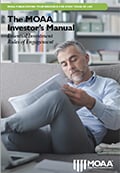(Updated Jan. 18 to add details on retired minimum distributions. Want more? Join MOAA on March 7 for a SECURE Act 2.0 webinar.)
The year-end federal funding omnibus bill includes long-debated legislation updating the rules for required minimum distributions (RMDs), increasing catch-up contribution limits, and making other major changes that could impact your retirement planning.
The so-called “SECURE Act 2.0” – following up on a 2019 law – passed the House overwhelmingly in March, but lingered for much of the year in a Senate committee. The language included in the omnibus, which passed both the House and Senate just before the Dec. 23 expiration of a government-funding continuing resolution, has many of the House provisions, with some modifications.
[RELATED: More 2023 Retirement Rule Changes]
Here are some of the highlights of the provision, which takes up more than 350 pages of the 4,155-page funding bill. A reminder: MOAA does not provide financial planning services and does not have a tax expert on staff, so be sure to discuss the effects of this legislation with your financial adviser and/or tax planner. For further details, consult this section-by-section breakdown of the legislation from the Insured Retirement Institute, a nonprofit association for the retirement income industry.
1. Major RMD Changes: The law updates current RMD rules, which require distributions to begin at age 72. The new rules:
- In 2023, the distribution age rises to 73.
- In 2033, it moves from 73 to 75.
Previously, if you failed to take an RMD, you were subject to a stiff 50% excise tax. SECURE Act 2.0 reduces the penalty to 25%, and if the failure is corrected in a timely manner, the excise tax is reduced to 10%.
You'll also no longer be required to take distributions from a Roth 401(k) or Roth Thrift Savings Plan (TSP) account, nor will you need to move funds from those accounts to a Roth Individual Retirement Arrangement (IRA) to avoid RMDs. See this recap of other RMD changes for more specifics.
[RELATED: Why You Should Factor the New SBP-DIC Rule Into Your Financial Plans]
2. New Catch-Up Contribution Rules: IRA catch-up contribution limits will be tied to cost-of-living adjustments. And there will be a higher catch-up contribution limit to retirement plans for those ages 60 to 63 – the greater of $10,000 or 50% more than the regular catch-up amount.
3. Retirement Plan Updates: 401(k) and 403(b) plans will be required to auto-enroll employees in the employer-sponsored retirement plan for contributions of between 3% and 10% for the first year. After that, they need to increase the percentage by 1% per year to at least 10% but not more than 15% unless the employee opts out.
Effective Jan. 1, 2024, employers will be able to treat qualified student loan payments as elective deferrals for purposes of matching contributions to employer-sponsored retirement plans. This allows employers to make contributions on behalf of workers who are foregoing saving for retirement to pay off student loan debt.
The bill includes auto-portability provisions to allow for easier movement between new and old employer retirement plans.
4. Protections for Military Spouses: Eligible small employers will be able to take a tax credit when they employ a military spouse and make them immediately eligible to participate in the employer’s defined contribution plan within two months. They must also make spouses immediately eligible for matching contributions and make them 100% vested in employer contributions.
[RELATED: 12-Week Military Parental Leave Benefit Will Be in Place by Next Month]
5. Emergency Savings Provisions: Individuals will be able to take withdrawals from their retirement accounts for certain emergency expenses without paying an additional 10% penalty. Only one distribution per year of up to $1,000 is allowed under the bill, which also creates pension-linked emergency savings accounts that could be accessed up to once a month.
6. New Annuity Requirements: Current RMD regulations prohibit certain guarantees that would make life annuities an attractive option as part of a defined contribution plan or IRA. The act removes these barriers.
7. Other Updates: The current Saver’s Credit seeks to encourage low- and middle-income individuals to contribute to retirement accounts by giving them a nonrefundable tax credit that phases out as income increases. Under SECURE Act 2.0, the credit is fixed at 50% for all eligible savers and changes from a credit to a federal matching contribution deposited into a taxpayer’s retirement account.
Also, beneficiaries of 529 college savings accounts will be able to roll over up to $35,000 over the course of their lifetime from their 529 account into their Roth IRA tax- and penalty-free. Annual contribution limits will apply.
[RELATED: Donate to the MOAA Scholarship Fund]
Look for more details on these changes and other financial updates at MOAA.org/Finance.
 Download The MOAA Investor’s Manual
Download The MOAA Investor’s Manual
This guide will help you better understand and manage your investments. It's available exclusively to PREMIUM and LIFE Members, who also may speak with MOAA benefits and financial counselors for further assistance.
Not a member? See below to learn more about joining MOAA or upgrading your membership.

